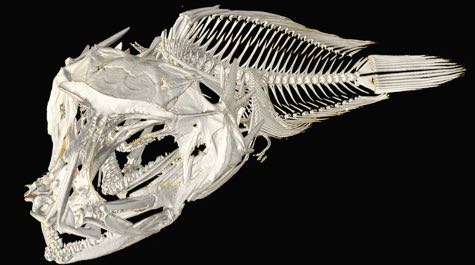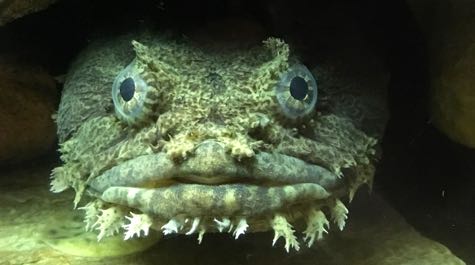Grad student uses high-tech medical device to study fish
CAT scans provide non-invasive means to investigate diversity
If you’ve spent time in the shallow waters of Chesapeake Bay or the Atlantic seaboard, you’ve likely encountered a fish with a face only a mother could love.
“Toadfishes are very different from a usual fish,” says Diego Vaz, who is studying the creatures for his doctoral research at William & Mary’s Virginia Institute of Marine Science. “They have a stocky body, a flattened head, and very large pectoral fins.” They also have bulging eyes, fleshy ‘whiskers’, and the ability to make noises variously described as grunts, growls, and hums. Some people think they sound like a vibrating cell phone.
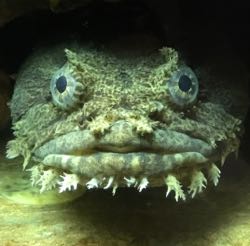 Oyster toadfish, also called oyster crackers for their ability to crush the shells of the tasty bivalves, are the only toadfish species in Chesapeake Bay, where they play an important role as predators of young crabs. But all told, there are thought to be 82 species worldwide, including several in the tropical waters off Brazil, where Vaz grew up. It is partly this diversity that drew him to the study of the toadfish family; he was also fascinated by their unusual reproductive behavior.
Oyster toadfish, also called oyster crackers for their ability to crush the shells of the tasty bivalves, are the only toadfish species in Chesapeake Bay, where they play an important role as predators of young crabs. But all told, there are thought to be 82 species worldwide, including several in the tropical waters off Brazil, where Vaz grew up. It is partly this diversity that drew him to the study of the toadfish family; he was also fascinated by their unusual reproductive behavior.
“Unlike most marine fishes, which have free-swimming larvae, oyster toadfish build nests and take care of the eggs” he explains. “And it is the males that do so—they attract females to the nest during mating season with vocalizations produced by a swim bladder that has sonic muscles attached to it.”
Yet details of toadfish behavior and biology are known for only a few species. “For most toadfishes,” says Vaz, “basic information is lacking—we’re unsure of their anatomy, modes of reproduction, age to maturity, whether males and females differ, and so on. Several species are known from just a few specimens, and one, a toadfish from South Africa, is based on study of a single fish.”
CAT scans for toadfishes
To help better understand toadfish biology and evolution, Vaz and his advisor, VIMS professor Eric Hilton, have turned to a new tool for marine research—computerized tomography, or what many know from a medical visit as a CAT or CT scan.
“CT scanning is a procedure that takes thousands of X-ray pictures of the same specimen from different angles,” says Vaz. “The result is a 3-D model of the skeleton.” He notes that it is particularly useful for studying the skeletal anatomy of uncommon species.
“A big advantage of CT scanning,” he says, “is that it is non-invasive. To investigate toadfish skeletons, I had asked to borrow specimens from museum collections around the world, but no museum will send out a rare specimen to go through an invasive procedure. CT scans fixed this issue.”
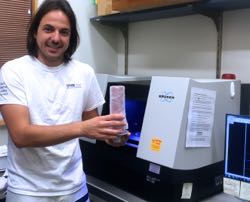 Vaz captures his CT scans in the lab of Dr. Adam Summers at the University of Washington’s Friday Harbor Laboratories. “Adam offers free use of his CT scanner to any researcher,” says Vaz. “I've been there three times since last year to scan biological material.”
Vaz captures his CT scans in the lab of Dr. Adam Summers at the University of Washington’s Friday Harbor Laboratories. “Adam offers free use of his CT scanner to any researcher,” says Vaz. “I've been there three times since last year to scan biological material.”
Summers operates the CT device as part of Scan All Fishes, a long-term effort to scan every species of fish worldwide for online access. “This is a very neat part of the project,” says Vaz, “to offer this free source of anatomical information for any purpose—from science to education.” He already has plans to incorporate some of the scanned images into a course for marine science minors at W&M.
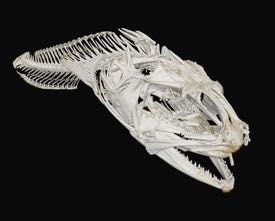
To visualize soft tissues, Vaz turns to old-fashioned dissection, and a procedure known as clearing and staining. For the latter, he says “You put a specimen through a series of chemicals that stain bones red, cartilage blue, and that leave other tissues transparent. Vaz calls the results “colorful and beautiful.”
Chemicals can also be used to reveal soft tissues in CT scans, but like dissection and clearing and staining, “these processes modify the specimen and you can’t reverse the changes,” says Vaz. He thus applies invasive methods only when a toadfish species is abundant and specimens easily obtained. Such is the case with most toadfish species from the mid-Atlantic. The Nunnally Ichthyology Collection at VIMS alone holds 42 specimens of the oyster toadfish Opsanus tau.
Putting toadfish in their place
CT scans and other analytical techniques have enabled Vaz to begin exploring some of the fundamental questions of toadfish biology. “Although researchers have long considered toadfishes a natural group that evolved from a single common ancestor,” he says, “we know very little about their evolution.”
A recent study explored evolutionary relationships among toadfishes by examining skeletons of one species in each of the 23 known genera. But Vaz says many questions remain. “How might the skeleton vary within each genus, or between juveniles and adults?” he asks. “And can anatomical features other than the skeleton aid our understanding of their evolution?”
Vaz also questions how toadfishes relate to other fish families. “Recent studies have placed toadfishes in different positions on the tree of life,” he says. “Historically, scientists thought they were most closely related to cods, angler-fishes, and cusk-eels. But the recent analyses agree they are just as closely related to other spiny fishes. So, there’s room to investigate this aspect too.”
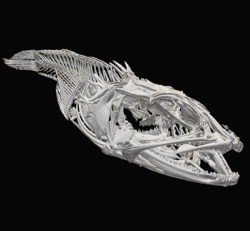 For Vaz, the importance of understanding the basics of toadfish anatomy is clear. “This knowledge is the foundation of biology,” he says. “It allows us to define and distinguish species. Every biological study relies on taxonomical and systematic knowledge to recognize its object of study. No agency can protect any organism and its diversity if it doesn't’t have this primary information.”
For Vaz, the importance of understanding the basics of toadfish anatomy is clear. “This knowledge is the foundation of biology,” he says. “It allows us to define and distinguish species. Every biological study relies on taxonomical and systematic knowledge to recognize its object of study. No agency can protect any organism and its diversity if it doesn't’t have this primary information.”
Vaz and Hilton stress the key role that museum collections play in supporting taxonomic research, and the importance of training scientists in the fundamental skills of species identification and classification.
“It’s not just systematic biologists that use classifications,” says Hilton. “So do conservation groups, lawmakers, and the general public, particularly for highly endangered groups of organisms.”
“I recently found the third known specimen of Barchatus indicus, a toadfish from the Red Sea and Somalia shore,” adds Vaz. “This specimen was sitting in Harvard’s Museum of Comparative Zoology for more than 50 years without being properly identified. You can’t understand or manage a fish or fishery if you can’t identify all its species.”


